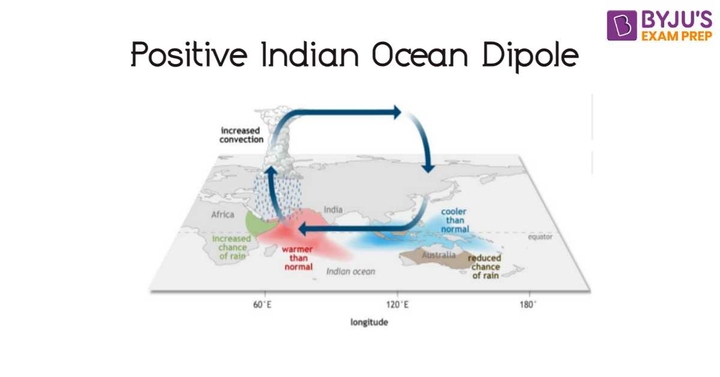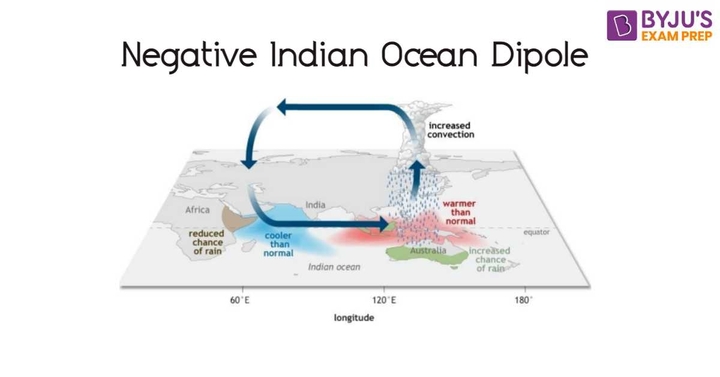Indian Ocean Dipole (IOD): Positive & Negative Indian Ocean Dipole
By BYJU'S Exam Prep
Updated on: November 14th, 2023
Indian Ocean Dipole is the variation in the surface temperature of the oceans between two regions (or poles,) — a Westerward pole in the Arabian Sea (the Western Indian Ocean) and an eastward pole in the Indian Ocean of Indonesia. This is often referred to as “Indian Nino” or IOD because it appears that the thermal and atmospheric conditions of the tropical Indian Ocean change evidently.
Indian Ocean Dipole is a very relevant topic in Indian geography and UPSC Mains GS Paper. Several questions have been put in the examination regarding its phases and other updates relating to the Indian Ocean dipole. You can download the PDF of the Indian Ocean dipole article from the link given below.
Table of content
What is the Indian Ocean Dipole (IOD)?
An atmosphere-ocean-linked phenomenon known as the Indian Ocean Dipole (IOD) occurs in the Indian Ocean and is marked by a disparity in sea surface temperatures. The Indian Ocean dipole (IOD) is the difference in temperature between the Eastern (Bay of Bengal) and western Indian oceans (Arabian Sea). La Nina and El Nino are the other two similar ocean phenomena to IOD, that affect the monsoons in India.
According to scientists, the IOD is an ENSO-like coupled ocean-atmospheric event that occurs in the equatorial region of the Indian Ocean. It is believed that the IOD and ENSO occurrences are connected by other Walker circulation’s westward expansion and its related Indonesian throughflow.
☛ Download Short Notes on Indian Ocean Dipole
Features of IOD
IOD (Indian Ocean Dipole) arise as a result of a variety of atmospheric occurrences that affect the water’s surface temperature. It starts in the equatorial regions of the Indian Ocean, develops in the months of April and May, and peaks in October.
- Cool water from the Indian Ocean rises in the east due to variations in temperature and wind.
- Warm and cold winds alternately blow in those directions. This is due to the pressure difference brought on by the temperature differences between the western and eastern portions of the Indian Ocean.
Phases of Indian Ocean Dipole (IOD)
The Indian Ocean dipole gives rise to 3 phases, namely, the positive phase, negative phase, and neutral phase.
Neutral phase of IOD: The IOD neutral face is when water from the pacific ocean flows through Indonesian islands, keeping the oceans warmer to Australia’s north-western direction. Westerly winds sweep along the equatorial belt as air rises above this region and stands through the western part of the Indian Ocean basin.
Positive Indian Ocean Dipole
Warm water can migrate to Africa during this phase because the westerly winds over the equator weaken. A surge of cold water from the deep ocean toward the east is also made possible by changes in the winds. During this, the tropical Indian Ocean has temperature differences, with the east experiencing cooler than usual water and the west experiencing warmer than usual water. It has been determined that the monsoon will benefit from this occurrence. This results in a positive Indian Ocean dipole.

Negative Indian Ocean Dipole
Negative phase of IOD: Warmer water accumulates towards Australia during this phase as the westerly winds along the equatorial line pick up speed. Due to this, the tropical Indian Ocean has temperature fluctuations, with the east experiencing warmer-than-normal water and the west experiencing cooler-than-normal water. This occurrence hinders the monsoon’s progress over India.

Impact of IOD on Southwest Monsoon
- Several studies have indicated that the central part of India receives more rain than usual during a good IOD year. The influence of El Nino Southern Oscillation (ENSO) was shown to be frequently encountered by a positive IOD index, resulting in enhanced monsoon rainfall in multiple ENSO years.
- On the other hand, a negative IOD supports El Nino, which causes a severe drought.
- Simultaneously, the Arabian Sea has more cyclones which is normally due to a positive IOD. Intense than usual cyclogenesis (formation of tropical cyclones) occurs in the Bay of Bengal as a result of negative IOD. During this period, cyclogenesis in the Arabian Sea is reduced.
- So, an IOD has the potential to either strengthen or diminish the effect of El Nino on the Indian rainfall pattern. Despite an El Nino year, India may see good rains if the IOD is positive.
Impact of Indian Ocean Dipole on El Nino
Oceanic dipoles in the Indian El Nino may have an indirect impact on SST (sea surface temperature) anomalies and variations.
In the Pacific‘s extreme east, SST is higher due to the Indian Ocean dipole, which can cause and worsen a number of El Nino-like variations and irregularities.
The ENSO cycle and IOD can interact significantly, speeding up any noise effects.
Events like El Nino and La Nina are normal components of the world climate structure. When the Pacific Ocean and the atmosphere that surrounds it depart from their balanced state for several seasons, these events take place. While La Nina occurrences are the opposite, with a continuous cooling of these same regions, El Nino episodes are linked to the heating up of central tropical Pacific and Eastern tropical Pacific regions.
Impact of IOD on Australia
Australian summer crops may suffer as a result of a delayed monsoon, which would lead to a 28% fall in the planted area in the year 2019-20.
In Southern and central Australia, a positive is often accompanied by below-average winter-spring precipitation, as well as a more severe fire season in the South East Australian region.
Indian Ocean Dipole [IOD] UPSC
The Indian Ocean dipole is a very relevant topic and an important part of the UPSC main syllabus. It is important to understand the topic thoroughly and keep oneself up-to-date with the current affairs regarding the latest Indian monsoon patterns and other Indian geography topics.
For this, you can refer to the UPSC study material. You can also download the UPSC previous year question papers for your practice.
☛ Download Indian Ocean Dipole UPSC Notes PDF
Indian Ocean Dipole UPSC Previous Year Question
Question – Prelims 2017 – With reference to the Indian Ocean dipole IOD sometimes mentioned in the news while forecasting the Indian monsoon, which of the following statements is/are correct?
- The IOD phenomenon is characterized by a difference in sea surface temperature between the tropical western Indian Ocean and the tropical eastern Pacific Ocean.
- An IOD phenomenon can influence an El Nino’s impact on the monsoon.
Select the correct answer using the code given below is
- 1 only
- 2 only
- Both 1 and 2
- Neither 1 nor 2
Answer – B
